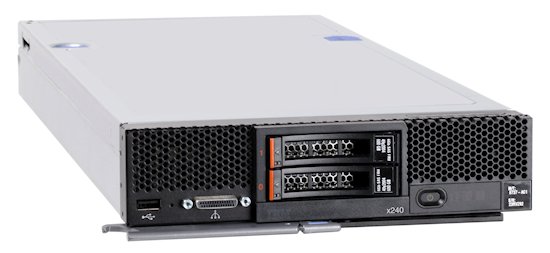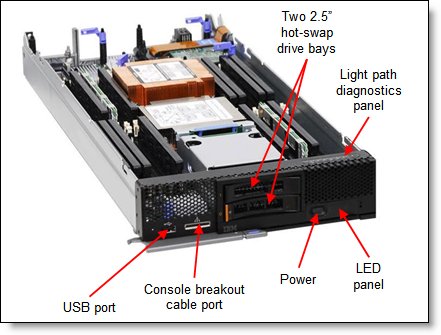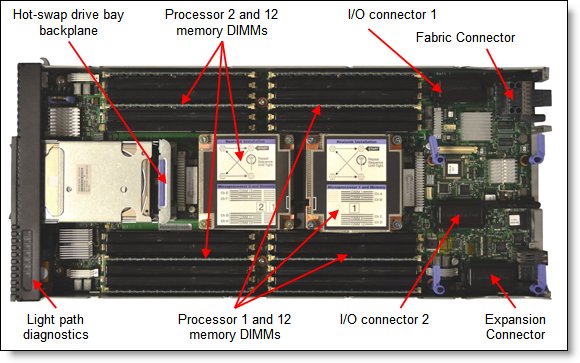| Components |
Specification |
| Models |
8737-x1x and 8737-x2x (x-config)
8737-15X and 7863-10X (e-config) |
| Form factor |
Standard-width compute node. |
| Chassis support |
Flex System Enterprise Chassis. |
| Processor |
Up to two Intel Xeon Processor E5-2600 product family CPUs with
eight-core (up to 2.9 GHz) or six-core (up to 2.9 GHz) or quad-core (up
to 3.3 GHz) or dual-core (up to 3.0 GHz). Two QPI links up to 8.0 GT/s
each. Up to 1600 MHz memory speed. Up to 20 MB L3 cache. |
| Chipset |
Intel C600 series. |
| Memory |
Up to 24 DIMM sockets (12 DIMMs per processor) using Low Profile
(LP) DDR3 DIMMs. RDIMMs, UDIMMs, and LRDIMMs supported. 1.5 V and
low-voltage 1.35 V DIMMs supported. Support for up to 1600 MHz memory
speed depending on the processor. Four memory channels per processor
(three DIMMs per channel). Supports two DIMMs per channel operating at
1600 MHz (2 DPC @ 1600MHz) with single and dual rank RDIMMs. Supports
three DIMMs per channel at 1066 MHz 1600MHz) with single and dual rank
RDIMMs. |
| Memory maximums |
With LRDIMMs: Up to 768 GB with 24x 32 GB LRDIMMs and two processors
With RDIMMs: Up to 384 GB with 24x 16 GB RDIMMs and two processors
With UDIMMs: Up to 64 GB with 16x 4 GB UDIMMs and two processors |
| Memory protection |
ECC, Chipkill (for x4-based memory DIMMs), memory mirroring, and memory rank sparing. |
| Disk drive bays |
Two 2.5" hot-swap SAS/SATA drive bays supporting SAS, SATA, and
SSD drives. Optional support for up to eight 1.8” SSDs. Up to 12
additional 2.5-inch drive bays with the optional Storage Expansion Node. |
| Maximum internal storage |
With two 2.5” hot-swap drives: Up to 2 TB with 1 TB 2.5" NL SAS
HDDs, or up to 2.4 TB with 1.2 TB 2.5" SAS HDDs, or up to 2 TB with 1 TB
2.5" SATA HDDs, or up to 3.2 TB with 1.6 TB 2.5" SATA SSDs. An intermix
of SAS and SATA HDDs and SSDs is supported. Alternatively, with 1.8”
SSDs and ServeRAID M5115 RAID adapter, up to 4 TB with eight 512 GB 1.8”
SSDs. Additional storage available with an attached Flex System Storage
Expansion Node. |
| RAID support |
RAID 0 and 1 with integrated LSI SAS2004 controller. Optional
ServeRAID M5115 RAID controller with RAID 0, 1, 10, 5, 50 support and 1
GB cache. Supports up to eight 1.8” SSD with expansion kits. Optional
flash-backup for cache, RAID 6/60, SSD performance enabler. |
| Optical and tape bays |
No internal bays; use an external USB drive. See http://support.lenovo.com/en/documents/pd011281 for options. |
| Network interfaces |
x2x models: Two 10 Gb Ethernet ports with Embedded 10Gb Virtual
Fabric Ethernet LAN-on-motherboard (LOM) controller; Emulex BE3 based.
x1x models: None standard; optional 1Gb or 10Gb Ethernet adapters. |
| PCI Expansion slots |
Two I/O connectors for adapters. PCI Express 3.0 x16 interface.
Includes an Expansion Connector (PCIe 3.0 x16) to connect an expansion
node such as the PCIe Expansion Node. PCIe Expansion Node supports two
full-height PCIe adapters, two low-profile PCIe adapters and two Flex
System I/O adapters. |
| Ports |
USB ports: One external. Two internal for embedded hypervisor
with optional USB Enablement Kit. Console breakout cable port providing
local KVM and serial ports (cable standard with chassis; additional
cables optional). |
| Systems management |
UEFI, Integrated Management Module 2 (IMM2) with Renesas SH7757
controller, Predictive Failure Analysis, light path diagnostics panel,
automatic server restart, remote presence. Support for IBM Flex System
Manager, IBM Systems Director and Active Energy Manager, and Lenovo
ServerGuide. |
| Security features |
Power-on password, administrator's password, Trusted Platform Module 1.2. |
| Video |
Matrox G200eR2 video core with 16 MB video memory integrated into
the IMM2. Maximum resolution is 1600x1200 at 75 Hz with 16 M colors. |
| Limited warranty |
3-year customer-replaceable unit and onsite limited warranty with 9x5/NBD. |
| Operating systems supported |
Microsoft Windows Server, Red Hat Enterprise Linux, SUSE Linux Enterprise Server, VMware ESXi. See the Operating system support section for specifics. |
| Service and support |
Optional service upgrades are available through ServicePacs®:
4-hour or 2-hour response time, 8-hour fix time, 1-year or 2-year
warranty extension, remote technical support for Lenovo hardware and
selected Lenovo and OEM software. |
| Dimensions |
Width: 215 mm (8.5”), height 51 mm (2.0”), depth 493 mm (19.4”). |
| Weight |
Maximum configuration: 6.98 kg (15.4 lb). |
-1000x1000.png)

-270x270.png)
-270x270.jpg)
-270x270.jpg)


